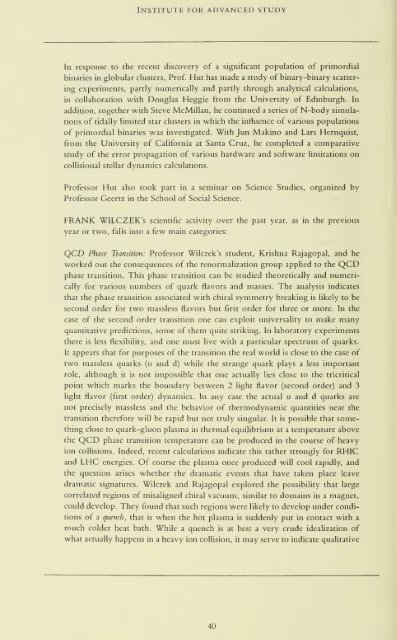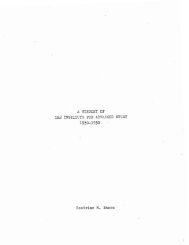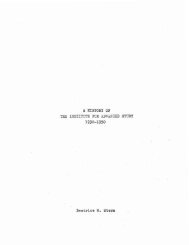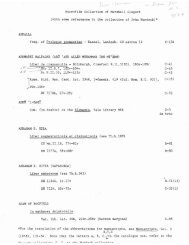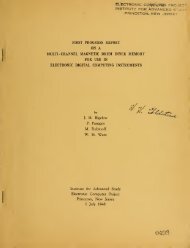Report for the Academic Year 1992-1993 - The Institute Libraries ...
Report for the Academic Year 1992-1993 - The Institute Libraries ...
Report for the Academic Year 1992-1993 - The Institute Libraries ...
Create successful ePaper yourself
Turn your PDF publications into a flip-book with our unique Google optimized e-Paper software.
<strong>Institute</strong> <strong>for</strong> advanced study<br />
In response to <strong>the</strong> recent discovery of a significant population of primordial<br />
binaries in globular clusters. Prof. Hut has made a study of binary-binary scatter-<br />
ing experiments, partly numerically and partly through analytical calculations,<br />
in collaboration with Douglas Heggie from <strong>the</strong> University of Edinburgh. In<br />
addition, toge<strong>the</strong>r with Steve McMillan, he continued a series of N-body simula-<br />
tions of tidally limited star clusters in which <strong>the</strong> influence of various populations<br />
of primordial binaries was investigated. With Jun Makino and Lars Hernquist,<br />
from <strong>the</strong> University of Cali<strong>for</strong>nia at Santa Cruz, he completed a comparative<br />
study of <strong>the</strong> error propagation of various hardware and software limitations on<br />
collisional stellar dynamics calculations.<br />
Professor Hut also took part in a seminar on Science Studies, organized by<br />
Professor Geertz in <strong>the</strong> School of Social Science.<br />
FRANK WILCZEK's scientific activity over <strong>the</strong> past year, as in <strong>the</strong> previous<br />
year or two, falls into a few main categories:<br />
QCD Phase Transition: Professor Wilczek's student, Krishna Rajagopal, and he<br />
worked out <strong>the</strong> consequences of <strong>the</strong> renormalization group applied to <strong>the</strong> QCD<br />
phase transition. This phase transition can be studied <strong>the</strong>oretically and numeri-<br />
cally <strong>for</strong> various numbers of quark flavors and masses. <strong>The</strong> analysis indicates<br />
that <strong>the</strong> phase transition associated with chiral symmetry breaking is likely to be<br />
second order <strong>for</strong> two massless flavors but first order <strong>for</strong> three or more. In <strong>the</strong><br />
case of <strong>the</strong> second order transition one can exploit universality to make many<br />
quantitative predictions, some of <strong>the</strong>m quite striking. In laboratory experiments<br />
<strong>the</strong>re is less flexibility, and one must live with a particular spectrum of quarks.<br />
It appears that <strong>for</strong> purposes of <strong>the</strong> transition <strong>the</strong> real world is close to <strong>the</strong> case of<br />
two massless quarks (u and d) while <strong>the</strong> strange quark plays a less important<br />
role, although it is not impossible that one actually lies close to <strong>the</strong> tricritical<br />
point which marks <strong>the</strong> boundary between 2 light flavor (second order) and 3<br />
light flavor (first order) dynamics. In any case <strong>the</strong> actual u and d quarks are<br />
not precisely massless and <strong>the</strong> behavior of <strong>the</strong>rmodynamic quantities near <strong>the</strong><br />
transition <strong>the</strong>re<strong>for</strong>e will be rapid but not truly singular. It is possible that some-<br />
thing close to quark-gluon plasma in <strong>the</strong>rmal equilibrium at a temperature above<br />
<strong>the</strong> QCD phase transition temperature can be produced in <strong>the</strong> course of heavy<br />
ion collisions. Indeed, recent calculations indicate this ra<strong>the</strong>r strongly <strong>for</strong> RHIC<br />
and LHC energies. Of course <strong>the</strong> plasma once produced will cool rapidly, and<br />
<strong>the</strong> question arises whe<strong>the</strong>r <strong>the</strong> dramatic events that have taken place leave<br />
dramatic signatures. Wilczek and Rajagopal explored <strong>the</strong> possibility that large<br />
correlated regions of misaligned chiral vacuum, similar to domains in a magnet,<br />
could develop. <strong>The</strong>y found that such regions were likely to develop under condi-<br />
tions of a quench, that is when <strong>the</strong> hot plasma is suddenly put in contact with a<br />
much colder heat bath. While a quench is at best a very crude idealization of<br />
what actually happens in a heavy ion collision, it may serve to indicate qualitative<br />
40


